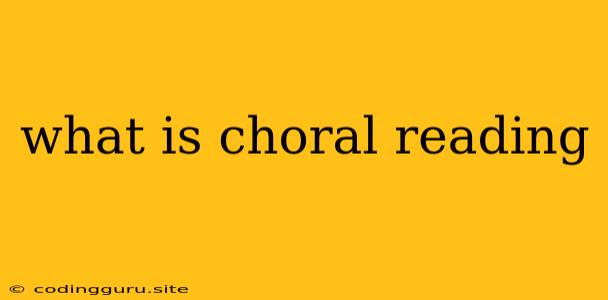What is Choral Reading?
Choral reading, also known as refrain reading, is a collaborative reading activity where a group of individuals read aloud together. It's a dynamic and engaging approach to reading that can enhance reading fluency, expression, and comprehension.
Why Choose Choral Reading?
There are numerous benefits to incorporating choral reading into the classroom or even just for personal reading practice. Some of the key advantages include:
- Improved Fluency: Reading aloud in unison helps students practice reading at a natural pace and with correct pronunciation.
- Enhanced Comprehension: The repeated reading and focus on the text in choral reading aid students in understanding the meaning and nuances of the material.
- Increased Confidence: Reading aloud in a group can build confidence in less confident readers, as they feel supported by their peers.
- Engaging Learning: Choral reading is a fun and interactive activity that can make reading more enjoyable for students.
- Promotes Teamwork and Collaboration: This activity fosters a sense of community and encourages students to work together towards a common goal.
Types of Choral Reading
There are various ways to implement choral reading, each with its own advantages:
1. Echo Reading: The teacher reads a phrase or sentence, and the students echo it back. This is particularly helpful for younger readers or when introducing new vocabulary.
2. Antiphonal Reading: The group is divided into two parts, each reading alternating sections of the text. This technique adds a rhythmic and dramatic element to the reading.
3. Line-by-Line Reading: Each student takes turns reading a line or a few lines of the text. This approach allows all students to participate actively and build their confidence.
4. Round Robin Reading: Students take turns reading a paragraph or a specific section of the text. This helps to build fluency and encourages students to listen attentively to each other.
5. Choral Reading with Props: Incorporating props, such as costumes, puppets, or visuals, can enhance engagement and bring the text to life.
Tips for Effective Choral Reading
Here are some helpful tips to make your choral reading sessions more effective:
- Choose appropriate texts: Select texts that are engaging, at an appropriate reading level, and allow for varied voices and expressions.
- Practice beforehand: Allow students to practice reading the text individually or in small groups before the choral reading session.
- Provide clear instructions: Explain the type of choral reading you'll be doing and any specific instructions or roles.
- Encourage active participation: Make sure all students have opportunities to participate and feel comfortable reading aloud.
- Focus on expression: Guide students to read with expression, paying attention to punctuation, tone, and pace.
- Use visuals and props: Incorporating visual aids and props can enhance engagement and understanding.
- Review and discuss: After the choral reading, take time to review the text, discuss the main points, and explore any vocabulary or concepts that were unclear.
Examples of Choral Reading
Here are some examples of texts that are well-suited for choral reading:
- Poetry: Poems often lend themselves well to choral reading due to their rhythmic structure and use of language.
- Songs: Singing along to familiar songs can be an enjoyable way to practice choral reading.
- Plays and scripts: Reading excerpts from plays can be particularly engaging, as students can take on different roles and bring the characters to life.
- Stories with repetitive phrases: Stories that feature repetitive phrases, such as nursery rhymes or folk tales, are ideal for choral reading.
Conclusion
Choral reading is a powerful tool for improving reading skills and fostering a love of reading. By engaging students in collaborative reading, teachers can create a positive and supportive learning environment where all students feel empowered to become confident and fluent readers.
